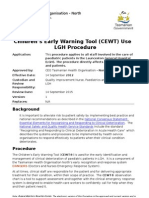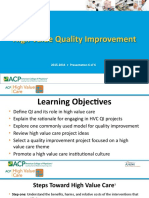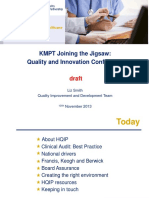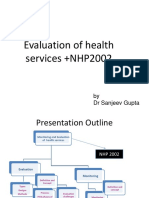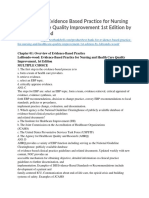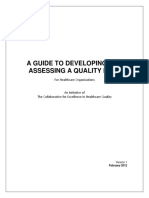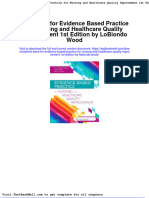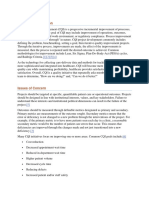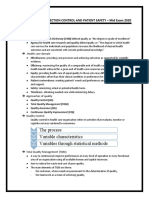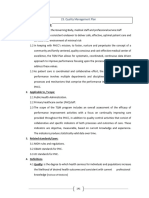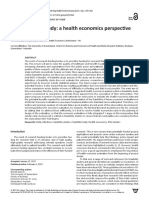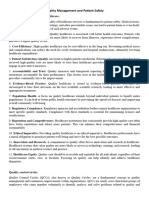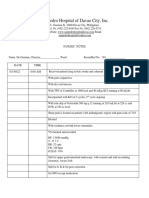How To Determine QI vs. Research
How To Determine QI vs. Research
Uploaded by
Cruz HernandezCopyright:
Available Formats
How To Determine QI vs. Research
How To Determine QI vs. Research
Uploaded by
Cruz HernandezOriginal Title
Copyright
Available Formats
Share this document
Did you find this document useful?
Is this content inappropriate?
Copyright:
Available Formats
How To Determine QI vs. Research
How To Determine QI vs. Research
Uploaded by
Cruz HernandezCopyright:
Available Formats
Determination of Quality Improvement versus Research
Questions frequently arise about whether or not certain projects qualify as human subjects research or if
they are considered quality improvement.
Quality Improvement (QI) has been defined as systematic, data-guided activities, designed to bring
about immediate improvements in health care delivery in particular settings. Initiators of QI projects
identify promising improvements, implement small scale changes, monitor results, and decide about
additional changes and wider implementation. Quality improvement is a core function of good clinical
care.
Research is defined by the federal government as a systematic investigation, including research
development, testing and evaluation, designed to develop or contribute to generalizable knowledge.
Research yields valid results through rigid implementation of a fixed protocol. The focus of research is
on long-term gains in knowledge.
Note there are many similarities between research and QI:
• Both involve a systematic investigation that is carefully designed to achieve reliable and valid
results.
• Both involve analysis of data.
• Both may involve the implementation of a new intervention.
• Both may result in a presentation or publication.
However, there are key differences between quality improvement and research projects.
• QI projects are often flexible and incremental in design, employing strategies such as a plan-do-
study-act cycle.
• QI uses data analysis to find out whether or not the workforce is following best practices and
professional guidelines.
• QI implements a new practice or process to improve (for example) workflow, patient safety, staff
expertise, cost effectiveness, etc.
• QI interventions often have been proven to be successful elsewhere and are widely accepted in the
profession/discipline. QI projects evaluate the best strategies to implement these interventions
locally.
• QI projects can help us characterize our population in order to better serve their needs or improve
their care.
• QI projects aim to directly benefit existing patients by implementing immediate local improvements.
• QI projects do not increase risk to patients beyond the risks that are involved in care they are already
receiving.
• QI tools are applicable primarily to the unique characteristics of our local setting.
• The results of QI projects typically are evaluated by an internal committee or executives who decide
whether or not to permanently adopt the new practice.
Informed consent
Informed consent is not required for quality improvement projects since they pose only minimal risk.
Because quality improvement is an integral aspect of normal health care operations, consent to be
included in QI projects is part of the patient’s consent to receive treatment.
Page 1 of 2 October 2019
Presentations and Publications
The federal agency overseeing research has stated that the act of presenting or publishing a quality
improvement project does not change its classification to be research.
Projects that are both Quality Improvement and Research
Some projects contain elements of QI but their focus is developing new, generalizable knowledge.
Additionally, activities that start as a QI initiative may evolve to have a research purpose. Examples of
projects that could be both QI and research are:
• Implementation of a new intervention to improve patient care and analysis of data to establish
scientific evidence of the intervention’s effectiveness
• Implementation of a novel approach that has not been extensively studied
• Development of new quality assessment or measurement tools
• Use of patient data in order to develop new clinical treatment guidelines
Projects that are both QI and research must be approved by the KUMC IRB before they are initiated.
Obtaining a Determination
Determinations about QI versus research are made on a case-by-case basis. Faculty members and other
researchers are encouraged to seek a formal determination about their project to ensure that compliance
requirements are met. A formal determination also may be helpful when submitting the manuscript. The
KUMC REDCap link to submit the request for a QI determination is posted at:
http://www.kumc.edu/compliance/human-research-protection-program/institutional-review-board/forms.html
Please review the instructions as well as the pdf version of the REDCap form to understand the
information required when submitting your request. Determinations are typically made within 2- 3
business days.
Additional Resources:
Lynn, Joann, et.al. The Ethics of Using Quality Improvement Methods in Health Care. Annals of
Internal Medicine. 2007; 146 (9): 666-673.
The federal Office for Human Research Protections provides Frequently Asked Questions on this topic
at http://answers.hhs.gov/ohrp/categories/1569
Page 2 of 2 October 2019
You might also like
- Critical Pathway: Clinical Pathways Have Four Main Components (Hill, 1994, Hill 1998)Document5 pagesCritical Pathway: Clinical Pathways Have Four Main Components (Hill, 1994, Hill 1998)pooja singh100% (2)
- Children's Early Warning ToolDocument7 pagesChildren's Early Warning ToolYwagar YwagarNo ratings yet
- NCP Anxiety and PainDocument12 pagesNCP Anxiety and PainCazze Sunio100% (1)
- Treatment Plannin1Document6 pagesTreatment Plannin1tibvalNo ratings yet
- 1 What Is Clinical Audit v3Document6 pages1 What Is Clinical Audit v3dmshossain100% (1)
- HVC Curriculum Presentation 6Document18 pagesHVC Curriculum Presentation 6Sulaiman AlqarawnehNo ratings yet
- Clinical AuditDocument82 pagesClinical Auditabuhajerah15100% (1)
- Clinical Audit ProtocolDocument14 pagesClinical Audit Protocolsami ketemaNo ratings yet
- How To Perform Clinical AuditDocument70 pagesHow To Perform Clinical AuditFaiq Syukri Bin SaparudinNo ratings yet
- Quality Improvement SupraptoDocument14 pagesQuality Improvement SupraptosupraptokarsNo ratings yet
- KMPT Quality and InnovationDocument33 pagesKMPT Quality and InnovationdenizenalexrNo ratings yet
- Clinical Audit For Medical StudentsDocument6 pagesClinical Audit For Medical StudentsAmal SaeedNo ratings yet
- Wa0000Document13 pagesWa0000cosmicnebula87No ratings yet
- Evaluation of Health ServicesDocument42 pagesEvaluation of Health Servicesdrsanjeev15No ratings yet
- Why Adopt ISO 9001 Certification in Hospitals? A Case Study of External Triggers and Sensemaking in An Emergency Department in NorwayDocument14 pagesWhy Adopt ISO 9001 Certification in Hospitals? A Case Study of External Triggers and Sensemaking in An Emergency Department in NorwayVishal PrajapatiNo ratings yet
- Clinical Audit - UH Bristol GuideDocument72 pagesClinical Audit - UH Bristol GuiderobertpattonNo ratings yet
- Bsit 1-A Artigo - Jade (Revised)Document16 pagesBsit 1-A Artigo - Jade (Revised)Shi Xin ZingkoNo ratings yet
- Artigo 4 - Introdução Às Ferramentas de Melhoria Da Qualidade para o ClínicoDocument7 pagesArtigo 4 - Introdução Às Ferramentas de Melhoria Da Qualidade para o ClínicoLuíze FoizerNo ratings yet
- Mzi040 PDFDocument6 pagesMzi040 PDFselamat parminNo ratings yet
- Mzi040 PDFDocument6 pagesMzi040 PDFselamat parminNo ratings yet
- Clinical AuditDocument22 pagesClinical AuditAsh-ShiddiqNo ratings yet
- 2020 - Quality Improvement Into PracticeDocument6 pages2020 - Quality Improvement Into PracticeMORADOMIANo ratings yet
- 2 Introduction To The Clinical Audit Cycle v4Document6 pages2 Introduction To The Clinical Audit Cycle v4bejarhasanNo ratings yet
- Test Bank For Evidence Based Practice For Nursing and Healthcare Quality Improvement 1st Edition by Lobiondo WoodDocument8 pagesTest Bank For Evidence Based Practice For Nursing and Healthcare Quality Improvement 1st Edition by Lobiondo WoodSusan Palacios100% (47)
- Francis, Keogh and Berwick - The Implications For Clinical AuditDocument25 pagesFrancis, Keogh and Berwick - The Implications For Clinical Auditwater87550No ratings yet
- A Framework For Evaluating Health Promotion ProgramsDocument24 pagesA Framework For Evaluating Health Promotion ProgramsKarla Monique PadrelananNo ratings yet
- Audit in Surgery: References Bailey and Love Surgery (27ed) Google, WikipediaDocument16 pagesAudit in Surgery: References Bailey and Love Surgery (27ed) Google, WikipediaRiya ShindeNo ratings yet
- Guide Developing and Assessing A Quality PlanDocument50 pagesGuide Developing and Assessing A Quality PlanesamNo ratings yet
- National Quality Forum Agency For Healthcare Research and Quality Meaningful UseDocument1 pageNational Quality Forum Agency For Healthcare Research and Quality Meaningful Uselouie roderosNo ratings yet
- Defining ResearchDocument4 pagesDefining ResearchjellyjohnNo ratings yet
- Full Download Test Bank For Evidence Based Practice For Nursing and Healthcare Quality Improvement 1st Edition by Lobiondo Wood PDF Full ChapterDocument36 pagesFull Download Test Bank For Evidence Based Practice For Nursing and Healthcare Quality Improvement 1st Edition by Lobiondo Wood PDF Full Chapterpapismlepal.b8x1100% (24)
- New Quality Improvement Plan For Reducing Patient Assessment Errors at Health FiDocument8 pagesNew Quality Improvement Plan For Reducing Patient Assessment Errors at Health Firexhudson100No ratings yet
- SIP Poster - Alison WEB PDFDocument1 pageSIP Poster - Alison WEB PDFNCPQSWNo ratings yet
- Policy and Procedure With The Steps Involved in Jcaho's CycleDocument15 pagesPolicy and Procedure With The Steps Involved in Jcaho's Cycleالمعتزبالله جاب اللهNo ratings yet
- Continuous Quality ImprovementDocument2 pagesContinuous Quality Improvementqdepartment138No ratings yet
- ACGME Outcome ProjectDocument8 pagesACGME Outcome ProjectsrisetyaNo ratings yet
- Quality Improvement ModelsDocument64 pagesQuality Improvement ModelsShahin Patowary100% (2)
- Seminar On Quality AssuranceDocument44 pagesSeminar On Quality AssuranceSucharitha Talari75% (4)
- Singapore JCI Department Service Quality Measurement Tracer (彭醫師製作-20160418醫務行政主管報告)Document39 pagesSingapore JCI Department Service Quality Measurement Tracer (彭醫師製作-20160418醫務行政主管報告)Chih-Tao ChengNo ratings yet
- Quality AssuranceDocument18 pagesQuality Assurancehemihema100% (1)
- 2015 Fdacms JWDocument30 pages2015 Fdacms JWDholakiaNo ratings yet
- Evaluation of Quality Improvement ProgrammesDocument6 pagesEvaluation of Quality Improvement Programmesujangketul62No ratings yet
- The Process Variable Characteristics Variables Through Statistical MethodsDocument6 pagesThe Process Variable Characteristics Variables Through Statistical MethodsSamNo ratings yet
- Patient Experience Measures From The Cahps Health Plan SurveyDocument9 pagesPatient Experience Measures From The Cahps Health Plan SurveyLee Jong SookNo ratings yet
- Continous Quality ImprovementDocument5 pagesContinous Quality ImprovementChukwu NedumNo ratings yet
- Module 5 Publication Review ArticleDocument12 pagesModule 5 Publication Review ArticleomaNo ratings yet
- SIP Poster - 4Document1 pageSIP Poster - 4NCPQSWNo ratings yet
- Pembagian JurnalDocument8 pagesPembagian JurnalHammam FarizNo ratings yet
- 0007 - Public Health ManagementDocument6 pages0007 - Public Health ManagementAustin Sams UdehNo ratings yet
- Guide For Clinical Audit Leads 21 Mar 11Document40 pagesGuide For Clinical Audit Leads 21 Mar 11ppeterarmstrongNo ratings yet
- Clinical Pathways Frequently Asked QuestionsDocument8 pagesClinical Pathways Frequently Asked Questionsagung kurniaNo ratings yet
- Final Clinical Audit Reporting Guide 2020Document24 pagesFinal Clinical Audit Reporting Guide 2020RobertaNo ratings yet
- Quality-Improvement PlanDocument11 pagesQuality-Improvement Planyhm70071No ratings yet
- Developingqiplan PDFDocument13 pagesDevelopingqiplan PDFAntonio SottoNo ratings yet
- Ibu Masy - The FS A Health Economic PerspectiveDocument4 pagesIbu Masy - The FS A Health Economic PerspectiveRinaNo ratings yet
- Complex Interventions GuidanceDocument39 pagesComplex Interventions GuidanceJulian Sanchez ViamonteNo ratings yet
- Understanding AuditDocument10 pagesUnderstanding AuditSara YehiaNo ratings yet
- Advances-Meyer 41 PDFDocument13 pagesAdvances-Meyer 41 PDFNenny Puji LestariNo ratings yet
- Quality Management and Patient SafetyDocument19 pagesQuality Management and Patient SafetyNishi DubeyNo ratings yet
- Quality Function Deployment in Healthcare A Literature Review and Case StudyDocument7 pagesQuality Function Deployment in Healthcare A Literature Review and Case Studyc5nr2r46No ratings yet
- Quality ImprovementDocument30 pagesQuality ImprovementAlejandro CardonaNo ratings yet
- Continuous Quality Improvement: Trisasi LestariDocument83 pagesContinuous Quality Improvement: Trisasi Lestarirunnikurniaharmuko_161083No ratings yet
- Introduction to Clinical Effectiveness and Audit in HealthcareFrom EverandIntroduction to Clinical Effectiveness and Audit in HealthcareNo ratings yet
- Case Presentation Acute Abdomen PediatricDocument17 pagesCase Presentation Acute Abdomen PediatricDevina TandiasNo ratings yet
- AscitesDocument5 pagesAscitesEeshuAomNo ratings yet
- Synopsis DR ABCDocument8 pagesSynopsis DR ABCFiaz medicoNo ratings yet
- VOYA USG Accident-Hospital IndemnityDocument37 pagesVOYA USG Accident-Hospital IndemnityDavid BriggsNo ratings yet
- Care of Clients With An AmputationDocument23 pagesCare of Clients With An AmputationLeonil Rota CorregidorNo ratings yet
- Document Review SheetDocument4 pagesDocument Review SheetMarvinNo ratings yet
- Pathophysiology PUDDocument8 pagesPathophysiology PUDTania Louise Pioquinto AbuanNo ratings yet
- Midterm Exam (Abpsych)Document7 pagesMidterm Exam (Abpsych)EsraRamosNo ratings yet
- Prostho IV - Slide 3 - Impression - Making - For - Complete - DenturesDocument82 pagesProstho IV - Slide 3 - Impression - Making - For - Complete - Denturesبراءة أحمد السلامات100% (1)
- Sem3 Nurs208 - Emillie Etcubanez Wohs 1Document14 pagesSem3 Nurs208 - Emillie Etcubanez Wohs 1api-314325486No ratings yet
- Nurse's NotesDocument2 pagesNurse's NotesDenise Loren O. PamaongNo ratings yet
- Medical Examination Form - Juvenile: Part 1: Statement To The Medical ExaminerDocument4 pagesMedical Examination Form - Juvenile: Part 1: Statement To The Medical ExaminerMohd Rafie HashimNo ratings yet
- MalnutritionDocument37 pagesMalnutritiondrtaa626289No ratings yet
- Drug StudyDocument5 pagesDrug Studytricia_fernandoNo ratings yet
- Debate ArgumentsDocument3 pagesDebate ArgumentsNur MNNo ratings yet
- Management of Ectopic TeethDocument21 pagesManagement of Ectopic TeethHaffie HafiziNo ratings yet
- Early Mobility in The Intensive Care Unit: Evidence, Barriers, and Future DirectionsDocument12 pagesEarly Mobility in The Intensive Care Unit: Evidence, Barriers, and Future DirectionsRaka dewiNo ratings yet
- HemoglobinopathiesDocument3 pagesHemoglobinopathiesChatie PipitNo ratings yet
- Acquired Brain en Una Tienda de LibrosDocument428 pagesAcquired Brain en Una Tienda de Libroslig100% (1)
- Ectopic PregnancyDocument27 pagesEctopic PregnancyuunuunuunNo ratings yet
- Step 1 of Tooth PreparationDocument3 pagesStep 1 of Tooth PreparationPhạm Thành NamNo ratings yet
- Pelvic ExamDocument3 pagesPelvic ExamLouis Gabriel LuchingNo ratings yet
- Human Blood: Name: Nuryuhainis Shazreen Class: 3 Jujur Teacher: PN Linda GomezDocument10 pagesHuman Blood: Name: Nuryuhainis Shazreen Class: 3 Jujur Teacher: PN Linda GomezRosdan JadidNo ratings yet
- TortsDocument2 pagesTortsGalanza FaiNo ratings yet
- Defibrillator: Dr. Sanjeev ChatniDocument31 pagesDefibrillator: Dr. Sanjeev Chatnigumarbio8417100% (1)
- Drugs Acting On Respiratory System 6640Document137 pagesDrugs Acting On Respiratory System 6640Umar Bakshi100% (1)
- Unlq6073 PDFDocument8 pagesUnlq6073 PDFSrinu VijayaNo ratings yet

